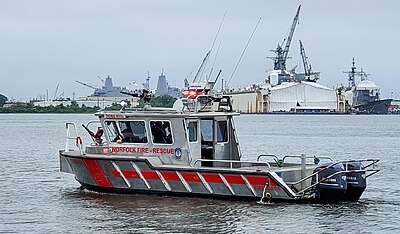Fireboats in Norfolk, Virginia: Difference between revisions
Pat Palmer (talk | contribs) mNo edit summary |
mNo edit summary |
||
| (One intermediate revision by one other user not shown) | |||
| Line 3: | Line 3: | ||
In 1924 [[Norfolk, Virginia]] commissioned the first of a number of '''fireboats in Norfolk, Virginia'''.<ref name=pilotonline2012-04-02/> She was a former [[United States Navy]] vessel, the [[USS Gen. Harvey H. Brown|USS '''Gen. Harvey H. Brown'']], christened the [[Vulcan (fireboat)|''Vulcan'']]. The ''Vulcan'' was a steam-powered vessel, requiring a crew of 18. She could project 6000 gallons per minute. She served until 1941. | In 1924 [[Norfolk, Virginia]] commissioned the first of a number of '''fireboats in Norfolk, Virginia'''.<ref name=pilotonline2012-04-02/> She was a former [[United States Navy]] vessel, the [[USS Gen. Harvey H. Brown|USS '''Gen. Harvey H. Brown'']], christened the [[Vulcan (fireboat)|''Vulcan'']]. The ''Vulcan'' was a steam-powered vessel, requiring a crew of 18. She could project 6000 gallons per minute. She served until 1941. | ||
In 2008, when the [[Vulcan II (fireboat)|''Vulcan II'']] was acquired, Norfolk's only vessel was {{convert | 22 | ft | m}} inflatable craft.<ref name=pilotonline2012-04-02/> The ''Vulcan II'' could project 2500 US gallons per minute. | In 2008, when the [[Vulcan II (fireboat)|''Vulcan II'']] was acquired, Norfolk's only vessel was {{convert | 22 | ft | m}} inflatable craft.<ref name=pilotonline2012-04-02/> The ''Vulcan II'' could project 2500 US gallons per minute. In 2013, she was supplemented by the ''[[Thomas Kevill (fireboat)|Thomas Kevill]]''.<ref name=pilotonline2013-06-22/><ref name=pilotonline2013-06-23/> She cost about half a million dollars, three quarters of which were provided through a [[FEMA Port Security Grant]]. Like other fireboats funded by FEMA, in addition to fighting fires, and search and rescue, she is sealed so she can provide a front-line response to chemical spills or attacks by chemical weapons, and to biological or radiological threats. She has advanced sensors, including infrared sensors that aid in locating a fire's hot-spots, and to picking out the heads of distressed boaters or swimmers, in the dark or under conditions of blinding fog or smoke. | ||
In 2013 she was supplemented by the ''Thomas Kevill''.<ref name=pilotonline2013-06-22/><ref name=pilotonline2013-06-23/> She cost about half a million dollars, three quarters of which were provided through a [[FEMA Port Security Grant]]. Like other fireboats funded by FEMA, in addition to fighting fires, and search and rescue, she is sealed so she can provide a front-line response to chemical spills or attacks by chemical weapons, and to biological or radiological threats. She has advanced sensors, including infrared sensors that aid in locating a fire's hot-spots, and to picking out the heads of distressed boaters or swimmers, in the dark or under conditions of blinding fog or smoke. | |||
==References== | ==References== | ||
| Line 55: | Line 53: | ||
}} | }} | ||
{{Fleets of fireboats by location}} | {{Fleets of fireboats by location}}[[Category:Suggestion Bot Tag]] | ||
Latest revision as of 16:01, 16 August 2024

In 1924 Norfolk, Virginia commissioned the first of a number of fireboats in Norfolk, Virginia.[1] She was a former United States Navy vessel, the USS 'Gen. Harvey H. Brown, christened the Vulcan. The Vulcan was a steam-powered vessel, requiring a crew of 18. She could project 6000 gallons per minute. She served until 1941.
In 2008, when the Vulcan II was acquired, Norfolk's only vessel was 22 ft (6.71 m) inflatable craft.[1] The Vulcan II could project 2500 US gallons per minute. In 2013, she was supplemented by the Thomas Kevill.[2][3] She cost about half a million dollars, three quarters of which were provided through a FEMA Port Security Grant. Like other fireboats funded by FEMA, in addition to fighting fires, and search and rescue, she is sealed so she can provide a front-line response to chemical spills or attacks by chemical weapons, and to biological or radiological threats. She has advanced sensors, including infrared sensors that aid in locating a fire's hot-spots, and to picking out the heads of distressed boaters or swimmers, in the dark or under conditions of blinding fog or smoke.
References
- ↑ 1.0 1.1 Patrick Wilson. What's in a name? - Norfolk Fire-Rescue Vulcan II, Virginia Pilot, 2012-04-02. Retrieved on 2019-09-10.
- ↑ Steve Earley. Photos: Norfolk commissions new fireboat, Virginia Pilot, 2013-06-22. Retrieved on 2019-09-10.
- ↑ Roy Bahls. Norfolk's newest fireboat named for city's first fire chief, Virginia Pilot, 2013-06-23. Retrieved on 2019-09-10.